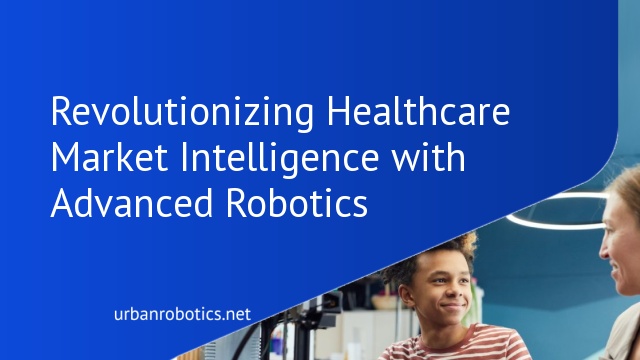Overview Of Healthcare Market Intelligence
Healthcare market intelligence uses data to understand trends and strategies in the healthcare sector. It involves collecting, analyzing, and interpreting data to predict future market behaviors. Robotics enhances this process by providing real-time data, enabling more accurate analysis.
Market intelligence covers several areas:
- Patient Needs Analysis: Robotics technologies gather and analyze patient data. For example, robotic systems track patient feedback and treatment outcomes, helping identify areas for improvement.
- Competitor Analysis: Robotics monitors competitor activities. It collects data from various sources, including social media and industry reports, providing insights into competitors’ strategies.
- Regulatory Insights: Robotics helps in tracking regulatory changes. Automated systems scan regulatory updates and compliance requirements, ensuring that healthcare providers stay informed about new laws and guidelines.
- Operational Efficiency: Robotics contribute to improving operational processes. For instance, robotic process automation (RPA) streamlines administrative tasks, reducing costs and improving productivity.
Integrating robotics into healthcare market intelligence drives more informed decision-making, leading to better patient care and enhanced operational performance.
Role Of Robotics In Healthcare
Robotics plays a crucial role in modern healthcare, enhancing precision and efficiency. Integrating robotics into healthcare market intelligence brings numerous benefits.
Types Of Robotics Used In Healthcare
Multiple types of robotics serve healthcare. Surgical robots perform precise operations, reducing recovery times. Diagnostic robots analyze medical images faster than humans. Rehabilitation robots help patients regain mobility. Telepresence robots allow remote consultations, expanding access to care. Together, these robotic systems optimize various healthcare sectors, from surgery to patient recovery, contributing to comprehensive market intelligence data.
Advantages Of Robotics In Healthcare Market Intelligence
Robotics provides several advantages in healthcare market intelligence. Real-time data collection from robotic systems improves analysis accuracy, enabling better predictions. Automation reduces human error, ensuring consistency in data. Robotics helps monitor vast amounts of information quickly, tracking market trends effectively. Enhanced data quality and rapid information processing enable more informed decision-making, ultimately improving patient outcomes and operational efficiency.
Key Applications Of Robotics In Market Intelligence
Robotics revolutionizes healthcare market intelligence by improving various aspects of data handling. Let’s explore some key applications.
Data Collection And Analysis
Robotics streamlines data collection using automated systems that gather information from multiple sources. This enables comprehensive datasets, reducing manual errors. Advanced robotics can also analyze this data in real time, identifying trends and anomalies quickly. For instance, robotics can track patient demographics and treatment outcomes to provide actionable insights, leading to more accurate healthcare strategies.
Predictive Analytics
Robotics enhances predictive analytics in healthcare by processing vast datasets to forecast future trends. Machine learning algorithms within robotic systems predict patient admission rates based on historical data. This allows healthcare facilities to manage resources effectively. It can also predict outbreaks of diseases, giving healthcare providers time to prepare and respond swiftly.
Patient Monitoring And Care
Robotics monitors patient health by using sensors and IoT devices to track vital signs. This continuous monitoring ensures that deviations in patient condition are promptly addressed. For example, wearable robots can alert medical staff to abnormal heart rates or blood pressure levels, facilitating timely interventions. This improves patient care and operational efficiency in healthcare settings.
Challenges And Limitations
Incorporating robotics into healthcare market intelligence presents several challenges and limitations. Understanding these issues helps address them effectively.
Technological Constraints
Complex integration with existing systems hampers seamless adoption of robotics in healthcare. Legacy systems often lack compatibility with modern robotics. Additionally, high costs of advanced robotic technologies deter widespread use, especially in smaller healthcare facilities. Limited interoperability between robotic systems and healthcare databases further complicates data management. Continuous updates and maintenance also pose significant hurdles, requiring specialized technical expertise.
Ethical Considerations
Data privacy remains a major concern in healthcare robotics. Protecting patient information from breaches is vital yet challenging. Moreover, the use of robotics raises questions about consent, particularly in patient monitoring scenarios. Ensuring transparency in data usage and sharing is essential to maintain trust. There are also fears of job displacement among healthcare workers, creating resistance to robotic integration. Addressing these ethical concerns requires clear policies and robust security measures.
Future Trends And Opportunities
Advancements in healthcare robotics present unprecedented opportunities for market intelligence. Emerging trends and innovations promise to reshape the industry landscape.
Innovations In Robotics Technology
Increased precision in surgical robots, like the da Vinci Surgical System, sets new standards in minimally invasive procedures. Telemedicine robots, such as those by InTouch Health, enable remote consultations, expanding access to care. Autonomous mobile robots (AMRs) like those developed by Aethon, streamline hospital logistics, reducing staff workload and improving efficiency. These innovations enhance operational capabilities and patient care quality, driving the market forward.
Integration With AI And Machine Learning
AI and machine learning applications in healthcare robotics revolutionize data processing and decision-making. Natural language processing (NLP) algorithms, used by IBM Watson, analyze vast datasets to provide insights. Predictive analytics tools, integrated into robotic systems, like those by Aidoc, foresee patient outcomes and optimize treatment plans. Machine learning models, employed in robotic surgery, continuously improve precision and outcomes. These integrations enhance predictive capabilities, leading to smarter, more efficient healthcare solutions.
Conclusion
Healthcare market intelligence with robotics is transforming our industry. By leveraging advanced technologies like AI and machine learning, we’re seeing significant improvements in data processing and patient care. Robotics not only streamlines operations but also opens new avenues for precision medicine and remote healthcare services.
Despite the challenges, the potential benefits make it clear that investing in healthcare robotics is a smart move. With the right policies and security measures, we can overcome technological and ethical hurdles. The future of healthcare looks promising with innovations that enhance efficiency and improve patient outcomes.
Let’s embrace this technological evolution and work towards a smarter, more efficient healthcare system.





